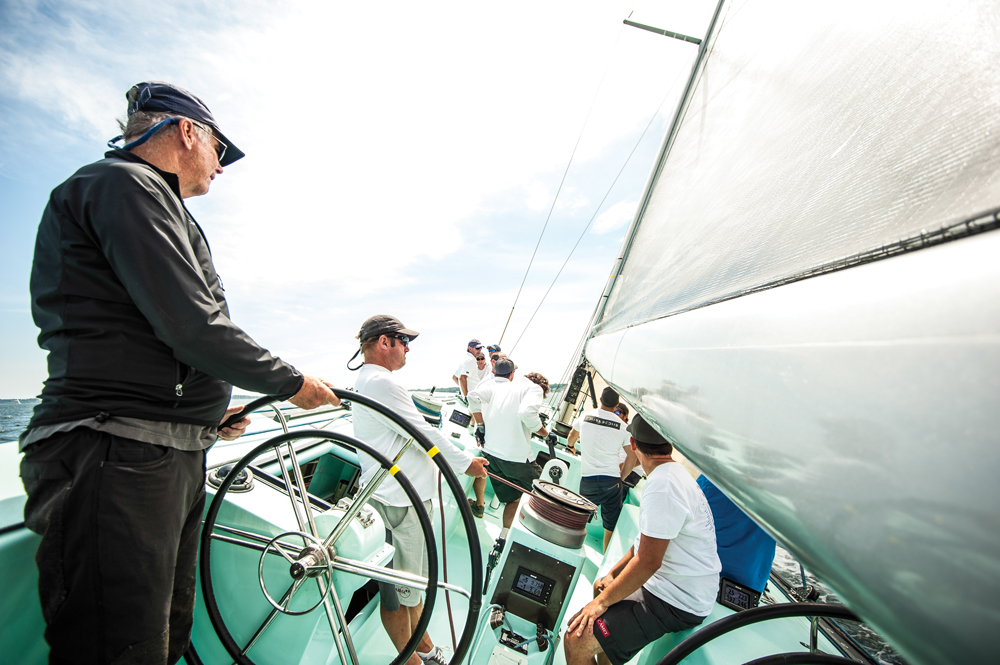Helming skills
The key to being a good helmsperson is equal parts concentration and practice
Just about every crew position on a sailboat comes down essentially to one word: concentration. I became a decent helmsman from my years of concentrating on spinnaker work. The spinnaker is very capricious. If you look away or are distracted by other problems on the boat, it seems to sense your inattention and collapses. If you have put in your hours, days or years of concentrating on your crew job, transitioning to the helm comes naturally.

One of the most pleasing rewards from sailing is getting the boat “in the groove,” in which the boat seems to lock in to a sweet spot of speed and comfort that just feels right. It takes the whole team to make it happen. The right combination of sails must be properly trimmed and the boat balanced perfectly. The helmsperson should have a slight weather helm without excessive heel and be concentrating on following wind shifts as they approach.
I use “helmsperson” because during our many years of Offshore Sailing race weeks taught by sailing experts, the women in the course often turned out to be the best at the helm. I think it was from the ability to concentrate and disregard distractions.
When you’re in the groove, time stands still. I have helmed for seven hours straight in the Sydney-Hobart Race and in the China Sea Race from Hong Kong to Manila. It could have been one hour for all I knew.
A large part of achieving this state of helming nirvana is the use of telltales. On smaller boats a Windex on the top of the mast is good for a glance or two, but too distracting to constantly use for wind direction. It comes into play best for downwind sailing since it is clear of flow interference from the sails. Telltales on the shrouds are the least effective at guiding a helmsperson, but telltales at three levels on genoa jibs are incredibly useful. I like to steer from a position where I can see all of them, particularly in light air.
Electronic wind instruments are excellent helpers, particularly at night, but you want to be careful not to focus exclusively on them. On a reach or a run at night you may be sailing a compass course, but there is much more to steering than just pointing the boat in the right direction. You will have to work the waves, heading up to pick up speed as the wave approaches from astern and then surfing down it as it lifts your boat. When speed is the goal, small adjustments that are judgment calls by the helmsperson can add up to important gains.
A sure way to struggle at the wheel, particularly when sailing at night is to fixate on the compass. Take a note from John Masefield’s poem “Sea Fever” and find “a star to steer her by.” Sailing by a star but glancing at the compass fairly often to ensure you are on course keeps you mentally sharp and eases the strain on your night vision. Having trimmers who are in sync with your steering is tremendously helpful.
No helmsman steers in a vacuum, and having a sharp crew makes the job infinity easier. Although it is better for the helmsperson to spot the puffs and lulls them self, it is very helpful to have someone calling out a gust hitting in 5-4-3-2-1 seconds and whether it looks like a header or a lift.
Remember that a gust brings the apparent wind aft creating a lift so it is worthwhile to anticipate the lift and steer up for it. That reduces the chance that the gust will heel the boat, creating strong weather helm. Remember any extraneous use of the rudder slows the boat down negating the benefit of the gust.
The opposite occurs in a lull, which can seem like a header. The helmsperson should steer down in a true heading wind shift, but if it’s a lull, be careful not to assume it’s a shift and decide to tack, assuming you’ll find a lift on the other tack. Tacking takes time, reduces your speed and would be wasted if you end up on a headed tack because it was not a shift, but just a lull.
Oscillating wind shifts call for a different approach. If you experience a lull in an oscillating wind, don’t keep falling off but push through it even if the jib shows a slight backing. You will come out better off once you push through the lull.
Tacking can be tricky for novice helmspeople, who tend to turn too far and come out of the tack far too low of the course. This often happens when the genoa trimmer is late on releasing the sheet and the jib flies across too fast for the trimmer on the new tack to trim it in quickly. The helmsperson tends to keep turning until the jib fills and then it’s a fight to trim it in.
On most boats this can be avoided by looking at the compass. Most have a lubber line straight ahead and additional line 90 degrees on either side. Most boats tack through slightly less than 90 degrees. If you turn the boat to the reading of the 90-degree lubber line and hold it there until the jib is trimmed in you should be able salvage an ill-timed release, build speed and gradually come up to course. Even better is to sight abeam across the compass and spot a landmark. Turn to the landmark. Give your crew plenty of warning about your intentions whatever maneuver you plan to take.
To initialize the tack, allow your weather helm to cause the boat to turn into the wind. Remember any unnecessary rudder movement slows the boat down. Then release the genoa sheet before the jib backs and at this point the helm should be turning the boat. Since the boat keeps turning after the helm has been centered, stop turning the boat with the helm early. This should result in a smooth tack that doesn’t slow the boat down much and gains a couple of boat lengths to windward.

When jibing, crew prompting is crucial. Someone, likely the mainsail trimmer, needs to be in charge of keeping the boom under control and that no one is sitting near the traveler. On large boats, it is safest to overhaul the main sheet to bring the boom amidships for the jibe.
Unlike a tack, a jibe is usually a very small change of course. As the boom crosses the midpoint of the deck and is let out on the new side it creates a strong weather helm when it fills on the new side. The helmsperson will have to counteract that tendency as if they were jibing back, though resulting only in sailing straight.
Being a good helmsperson is a skill that takes some practice and the ability to block out distractions while still staying in tune with the crew and what’s happening around you. To paraphrase Kipling, if you have the ability to maintain concentration when all around you loses theirs, you are a helmsman.

Comments